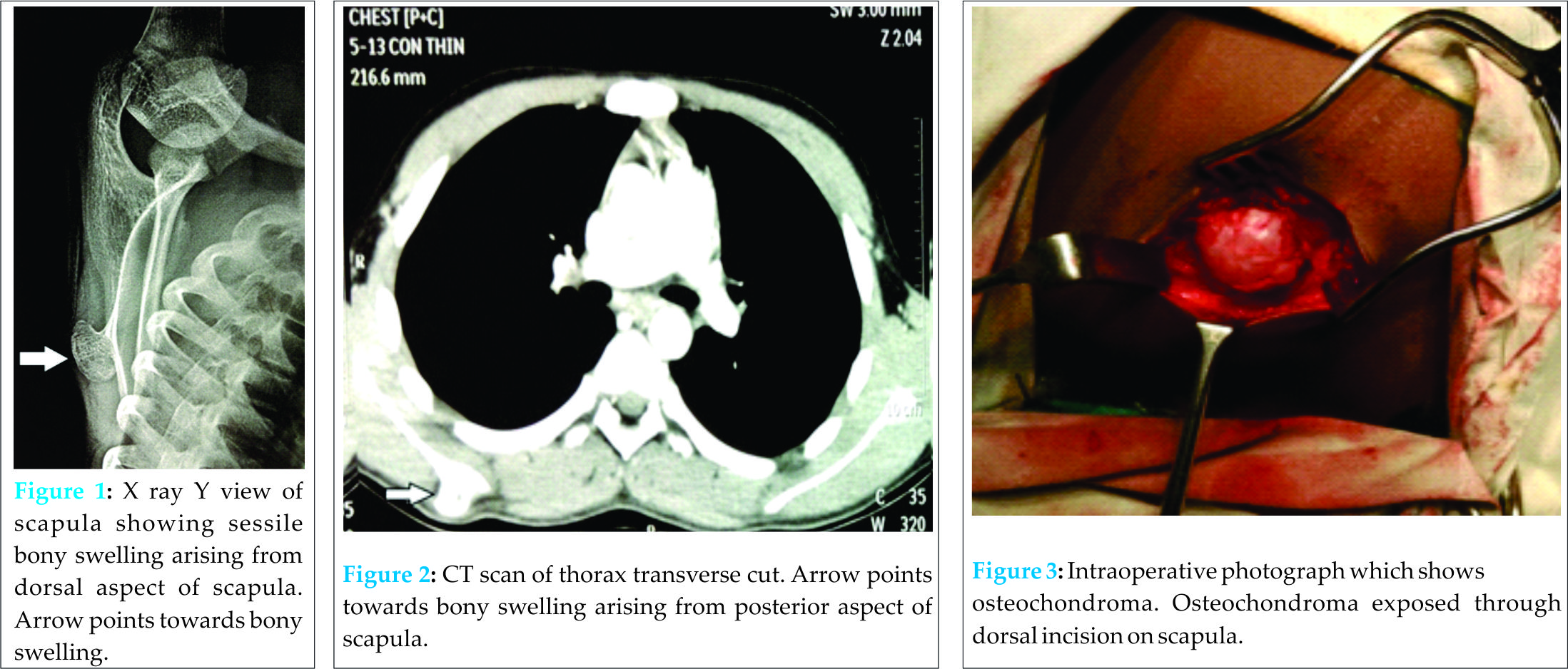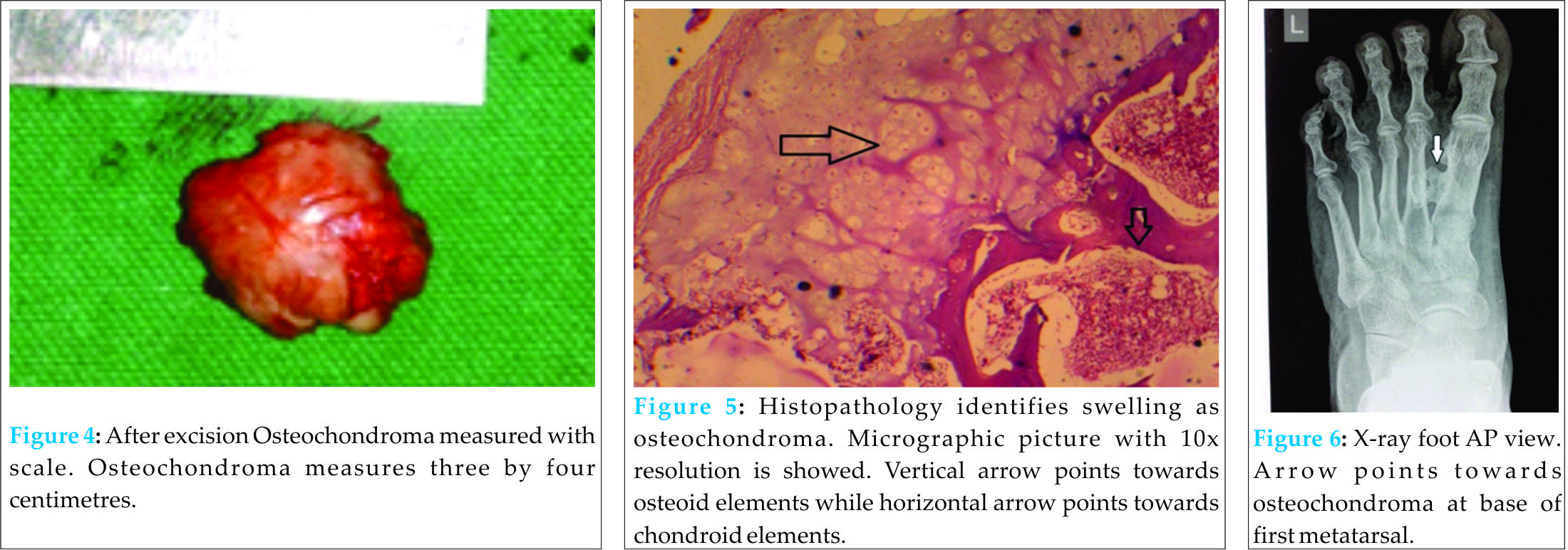[box type=”bio”] What to Learn from this Article?[/box]
While treating any patient, detailed analysis of symptoms is necessary. In addition to common presentations we should think about unusual presentations of diseases. Attempts should be made to diagnose underlying pathology rather than symptomatic treatment of patient.
Case Report | Volume 6 | Issue 1 | JOCR Jan-Mar 2016 | Page 52-54 | Pravin U Jadhav, Santosh N. Banshilkar, Binoti A. Seth, Arvind B. Goregaonkar DOI: 10.13107/jocr.2250-0685.376
Authors: Pravin U Jadhav[1], Santosh N. Banshilkar[1], Binoti A.Seth[1], Arvind B. Goregaonkar[1]
[1] Department of Orthopaedics, Lokmanya Tilak municipal medical college, Sion, Mumbai-400022. Maharashtra. India.
Address of Correspondence
Dr. Pravin U. Jadhav,
Assistant Professor, Department of orthopaedics, Lokmanya Tilak municipal medical college, Sion, Mumbai – 400022. Maharashtra. India. Email – pravinjadhav99@yahoo.com
Abstract
Introduction: Osteochondromas are benign tumours of the skeletal system. Their commonplace of occurrence is around growing ends of long bones like lower end of femur and upper end of tibia, but literature describing their incidence around flat bones of body like pelvis, scapula and small bones of hand, foot is rare.
Case Report: We describe two cases of osteochondromas at unusual sites, one on the dorsal aspect of scapula and other at the base of first metatarsal. Patient with scapular osteochondroma had difficulty in sleeping in supine position while that with metatarsal osteochondroma had discomfort while walking.
Conclusion: Depending on the site of occurrence, osteochondromas can give rise to different local symptoms. Possibility of osteochondroma should be kept in mind during differential diagnosis of bony swelling in flat bones as well as small bones.
Keywords: Unusual sites, osteochondroma, bony swelling.
Introduction
Osteochondromas are the most common benign tumours of the bone with an incidence of 30% to 40% [1]. These lesions are thought to arise due to congenital defect in perichondrium [1]. These generally occur near the growth plates of long bones and most commonly form around the shoulder or knee [1]. Literature describing involvement of other anatomic sites is scarce.These can arise in any bone which is formed from cartilage [2]. Scapular osteochondromas represents three to four percent of all osteochondromas [3]. Osteochondromas around small bones of foot are also rare. Here we present two case scenarios with osteochondromas at dorsal aspect of scapula and base of first metatarsal.
Case Presentation
Case one– Twelve year old boy presented to our OPD with difficulty in sleeping in supine position. On examination, a bony hard swelling was detected at the dorsal aspect of right scapula measuring about three into four centimetres. Swelling was fixed to the underlying bone and moved with movement of scapula. Range of movement of shoulder was normal. There was no tenderness around the swelling. X ray of scapula (scapular Y view) showed sessile swelling originating from scapula (Fig. 1). Same thing was confirmed on CT scan of thorax (Fig. 2). Swelling was excised en-mass (Figs. 3 and 4). 
Case two- Forty years old male presented to us with discharging sinus on plantar aspect of right foot since last three months. He remembered of an injury by a glass piece few years ago. He also had discomfort on weight bearing in same foot since childhood. On X-ray (Fig. 6),
Discussion
Osteochondromas or exostoses are benign bone tumours. Commonly, they present as painless bony hard swellings around growing ends of long bones like femur and tibia [3]. They are usually asymptomatic. Most of the patients seek treatment forcosmetic reasons. Pain presents secondary to fracture through stalk of pedunculated osteochondromas or malignant change. Rarely patients present with local symptoms due to pressure on surrounding nerves and vessels [4]. In our case with dorsal scapular osteochondroma, patient had difficulty in sleeping in supine position. X-rays are usually diagnostic which show cortex and medulla of swelling continuous with that of parent bone. CT scan may be needed in certain situations where swelling is not easily visible as in case of volar scapular osteochondromas to make diagnosis [3]. Histopathological examination also confirmed the diagnosis [5]. Extraperiosteal resection is the treatment of choice. Recurrences are common.
Few cases of solitary osteochondroma of scapula have been reported in literature. Most of these are case reports describe osteochondroma on volar aspect of scapula causing pseudo-winging of scapula. Description of symptomatic solitary osteochondroma on dorsal aspect of scapula is rare. Nathan et al in 2010 [6] described their experience of treating five volar, two dorsal and one inferior scapular osteochondroma over a period of 13 years. At a mean time of 4.17 years post-resection, no sign of recurrence was found in seven patients
Yadkikar et al [7], in year 2013 presented a case with dorsal scapular osteochondroma, who had difficulty in sleeping in supine position. Salgia et al [8] in 2013 also treated patient with similar presentation but patient was from higher age group and was predominantly concerned about cosmetic appearance. Patient improved symptomatically after excision of lesion and at one year follow up there is no evidence of recurrence of lesion.
Osteochondroma around metatarsals of foot are very rarely encountered. Only few case reports have published about metatarsal osteochondromas till date. Yildirim et al [9] in 2010 reported solitary giant osteochondroma of fifth metatarsal in army recruit. Shtofmakher et al [10] in 2015 and Molitor [11] in 1997 reported symptomatic osteochondroma arising from first metatarsal. All of these patients presented with pain on weight bearing. We had similar experience. Our patient also had dull aching pain on plantar aspect of right foot on weight bearing and a discharging sinus secondary to retained foreign body.
Conclusion
Depending on site of occurrence, osteochondromas have different symptoms. So in patients presenting with bony swellings around flat and small bones of feet, differential diagnosis of ostechondromas should be kept in mind.
Clinical Message
Though rare, osteochondromas do occur over flat and small bones. This differential diagnosis should keep in mind while dealing with bony swellings at these areas.
References
1. Puri A and Agrawal M G. Current concepts in bone and soft tissue tumours. Textbook of orthopaedic oncology. Paras Medical Books Pvt. Ltd.;72-77.
2. Kumar Y, Shervegar S -, Gadi D, Rahul. Sessile Osteochondroma of Scapula, a Rare Case Report. Journal of Clinical and Diagnostic Research 2014; 8(3):174-175.
3. MahajanS , Mahajan N, Singh P, Shikari A, Sharma R. Scapula a rare localization of osteochondroma: a case report. The Internet Journal of Orthopedic Surgery 2008;14(1).
4. Essadki B, Moujtahid M, Lamine A, Fikry T, Essadki O, Zryouil B. Solitary osteochondroma of the limbs: clinical review of 76 cases and pathogenic hypothesis. ActaOrthopBelg 2000;66:146–153.
5. Milgram JW. The origins of osteochondromas and enchondromas. A histopathologic study. ClinOrthopRelat Res. 1983; (174):264-284.
6. Nathan L. Frost, Parada S A, Manoso M W, Arrington E, Benfanti P. Scapular osteochondromas treated with surgical excision. Orthopedics 2010;33(11).
7. Yadkikar SV, Yadkikar VS. Osteochondroma on dorsal surface of the scapula in 11 year old child- a case report. Int J Med Res Health Sci.2013;2(2):305-308.
8. Salgia A, Biswas S K, Agarwal T, Sanghi S. A rare case presentaion of osteochondroma of scapula. Medical Journal of Dr. D.Y. Patil University. 2013;6(13).
9. Yıldırım C, Rodop O, Kus M¸ Orçun S, Gamsızkan M. Giant solitary osteochondroma arising from the fifth metatarsal bone: A Case Report.The Journal of Foot & Ankle Surgery 2010;49:298.
10. Shtofmakher G, Kaufman M A, Bhoola P H, Patel A S, Rice S M, Cohen R E.Multiple osteocartilaginous exostoses of the lower extremity: A case report. The Foot 2015;25(1):62-65.
11. Molitor P J A, Myint S. An unusual solitary osteochondroma arising from the first metatarsal bone. The Foot 1997;7(1):37-39. Consent:
All the patients described in this case report have given informed consent for case report to be published.
| How to Cite This Article: Jadhav PU, Banshilkar SN, Seth BA, Goregaonkar AB. Case series of Osteochondromas Presenting at Unusual Sites. Journal of Orthopaedic Case Reports 2016 Jan-Mar;6(1): 52-54. Available from: https://www.jocr.co.in/wp/2016/01/02/2250-0685-376-fulltext/ |
[Full Text HTML] [Full Text PDF] [XML]
[rate_this_page]
Dear Reader, We are very excited about New Features in JOCR. Please do let us know what you think by Clicking on the Sliding “Feedback Form” button on the <<< left of the page or sending a mail to us at editor.jocr@gmail.com






